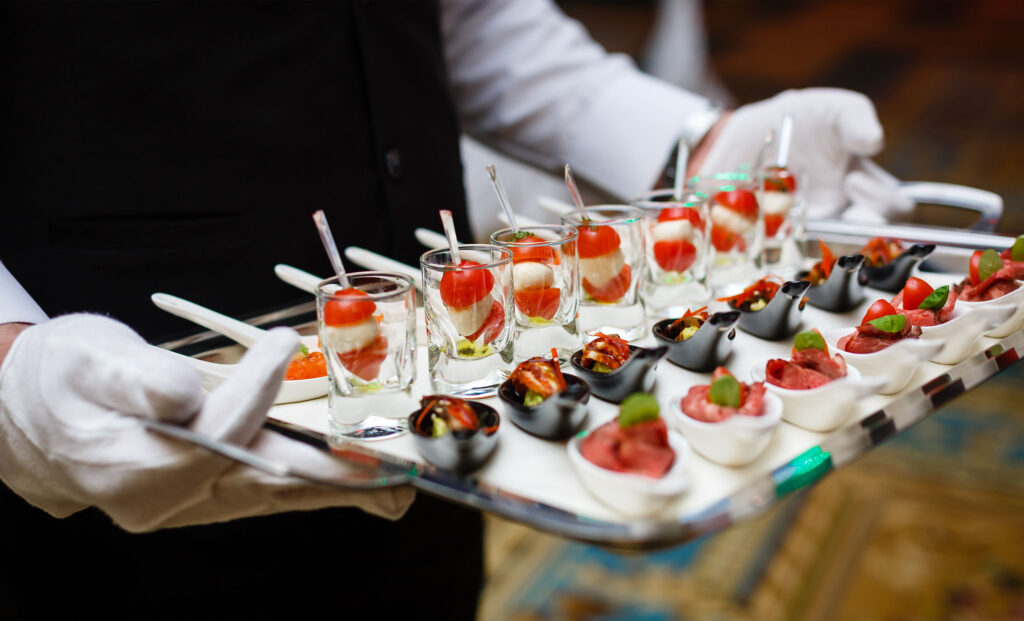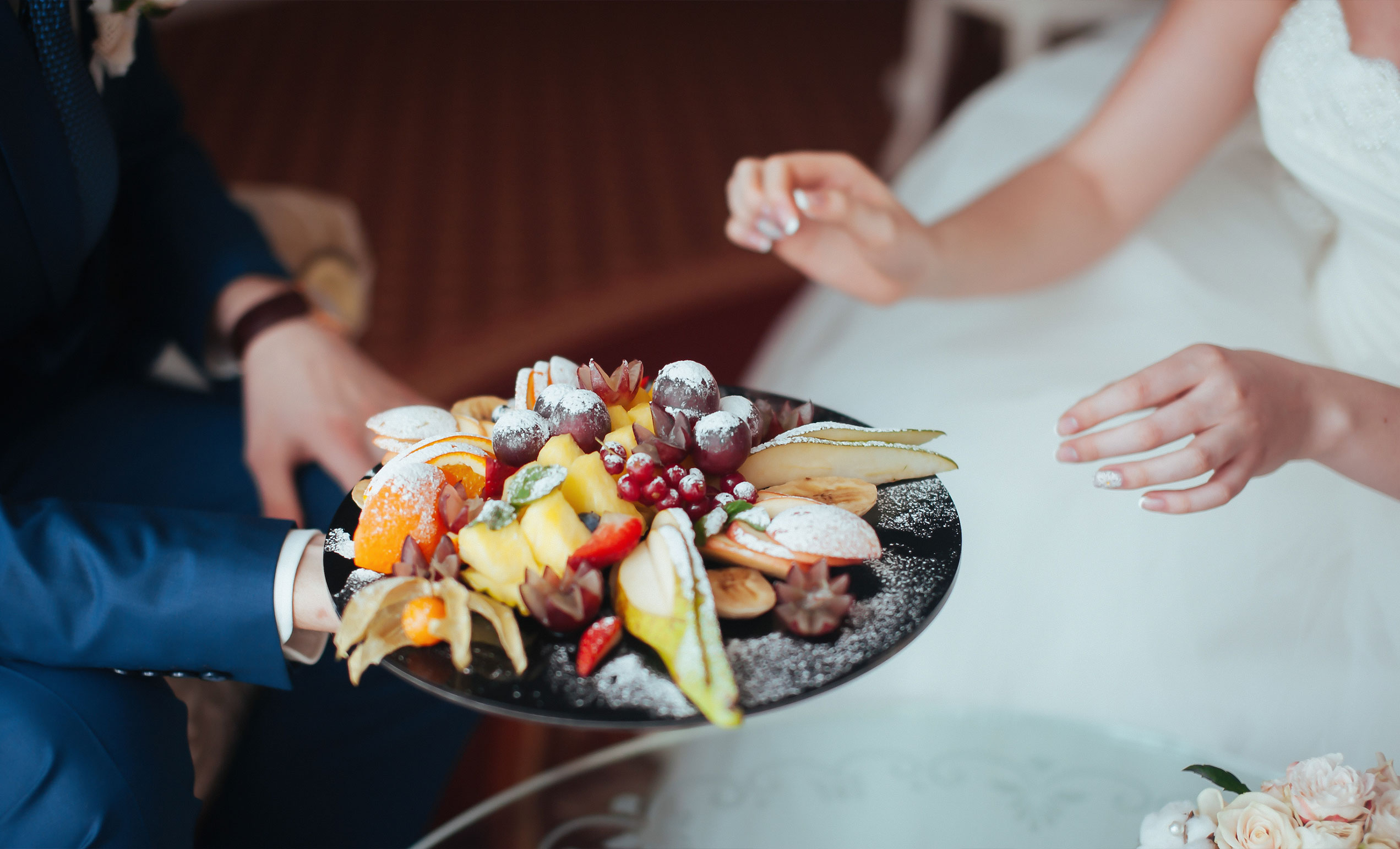Setting a budget for the food and beverages:
When it comes to setting a budget for the food and beverages at your wedding, it’s important to determine how much you can allocate to this aspect of the wedding and make sure to stick to it. This can help to ensure that you don’t overspend on food and drinks and that you have enough money to cover other important aspects of your wedding.
One way to determine your food and beverage budget is to consider the total number of guests and the type of meal you want to serve. For example, a formal sit-down dinner will typically be more expensive than a buffet or a reception with heavy appetizers. Additionally, you should also factor in the cost of beverages, including alcohol, as well as staffing costs and rental equipment.
Another important thing to consider is the location of your wedding and the local market prices. Venue prices can vary greatly depending on the location and the time of year, and the cost of food and drinks will also be affected by the local market prices.
Once you have determined your budget, it’s important to stick to it by being mindful of your spending and making sure to compare prices and negotiate with vendors. You can also look for ways to cut costs, such as choosing a less expensive menu or opting for a cheaper wine list.
Finding the right caterer:
Finding the right caterer is an important step in planning your wedding, as the food and drink service will play a big role in the overall success of the event. One way to find the right caterer is to research different caterers and find one that fits your budget, style, and preferences.
When researching caterers, it’s important to consider factors such as the cost of the service, the types of food and drinks offered, and the caterer’s experience and reputation. You can ask for recommendations from friends and family, check online reviews and also ask for references.
It’s also a good idea to schedule a tasting with potential caterers. This will give you the opportunity to sample their food and see how they handle service, presentation, and timing. You can also ask them about their service options and what they can offer to match your preferences and budget.
It’s also important to consider the type of service you want. Some caterers offer full-service catering, which includes preparing and serving the food, as well as providing staff and rental equipment, while others offer drop-off service, where the food is prepared and delivered but not served.
Choosing a menu:
Choosing a menu for your wedding is an important step in the planning process, as the food and drink service will play a big role in the overall success of the event. One way to choose a menu that will appeal to a wide range of guests is to take into account dietary restrictions, seasons and the availability of ingredients.
When deciding on a menu, it’s important to consider any dietary restrictions or allergies that your guests may have, such as gluten-free, vegetarian, or kosher. It’s a good idea to offer a variety of options to accommodate all guests, or at least a few options that can be modified to suit different dietary needs.
Another important consideration is the season and availability of ingredients. Using fresh, in-season ingredients can help to ensure that the food is at its best and can help to keep costs down. It’s also a good idea to consider the climate and weather when choosing a menu, for example, if the wedding is in summer, you might want to consider lighter fare that won’t weigh guests down in the heat.
Additionally, you should also consider your guests preferences and tastes when choosing a menu, while you want to appeal to a wide range of guests, you also want to make sure that the menu reflects your own tastes and preferences.

Tasting:
Before finalizing your menu, it’s important to schedule a tasting with your caterer to sample different dishes and make sure they are up to your expectations. A tasting will give you the opportunity to try a variety of dishes, see how the food is presented and ensure that it meets your taste, dietary needs and expectations for the big day.
When scheduling a tasting, it’s important to work with your caterer to determine the best time to do it. It’s usually done a few months before the wedding, and it’s a good idea to schedule it when you have a good idea of your final guest count.
During the tasting, you will have the opportunity to sample a variety of dishes, including appetizers, entrees, and desserts. It’s also a good idea to bring along a small group of people, such as your partner, family members, or close friends, to get their opinion and feedback.
It’s also important to communicate with your caterer about your preferences and any dietary restrictions you have, this will help to ensure that the food is prepared correctly and that all your guests will be able to enjoy the meal.
Planning the presentation:
Planning the presentation of the food is an important aspect of the wedding planning process, as it can help to create a visually appealing and memorable experience for your guests. One way to plan the presentation is to work with your caterer to come up with a creative way to present the food.
One way to create a visually appealing presentation is to use unique serving dishes, such as vintage plates or mismatched china. This can add a touch of elegance and charm to the table setting and make it stand out.
Another way to create a visually appealing presentation is to use different heights, textures, and colors to create a dynamic and interesting display. For example, you can use tall vases and floral arrangements to create a sense of height and depth, or use different colored linens to add a pop of color to the table.
Another way to create a memorable presentation is to incorporate a theme into the presentation. This can be done by using elements that reflect the theme, such as rustic wood and greenery for a nature-inspired theme or a vintage vibe for a vintage inspired theme.
Planning for alcohol:
Planning for alcohol is an important aspect of the wedding planning process, as it can have a big impact on the overall success of the event. When deciding on a drinks menu and a plan for serving alcohol, there are several factors to consider, including the type of bar service, the cost, and the preferences of your guests.
One of the first decisions to make is whether to have a cash bar, open bar, or a limited bar. A cash bar means that guests will pay for their own drinks, an open bar means that the host will pay for all drinks, and a limited bar means that the host will pay for a certain amount or certain types of drinks.
When deciding on the type of bar service, it’s important to consider your budget and the preferences of your guests. A cash bar can be a good option for those on a tight budget, but it may not be as popular with guests. An open bar can be a more expensive option, but it can be a great way to ensure that guests have a good time. A limited bar can be a good middle ground, as it allows you to control costs while still providing guests with a good selection of drinks.
Special requests:
When planning your wedding menu, it’s important to be prepared to accommodate any special requests from your guests, such as dietary restrictions or allergies. Not only is it important to consider the needs of your guests, but it also shows that you care about their comfort and well-being.
Dietary restrictions can include gluten-free, vegetarian, vegan, kosher or halal, among others. It’s important to have options for guests with these restrictions, so they can enjoy the meal without feeling left out. It’s a good idea to work with your caterer to come up with a few options that can be modified to suit different dietary needs.
Food allergies can be more serious, it’s crucial to have a plan in place to accommodate guests with severe allergies and make sure that the food is prepared in a way that minimizes the risk of cross-contamination. This can include using separate kitchen equipment or having separate options for those with allergies.
It’s also a good idea to make sure that your guests are aware of any special options available to them. This can be done by including a note on the invitation or by having a special table card that highlights the options available.

Don’t forget the dessert:
When planning your wedding menu, don’t forget about the dessert! A delicious and visually appealing dessert can be the perfect way to complete the meal and make a lasting impression on your guests.
When choosing a dessert, it’s important to consider the preferences of your guests, as well as the theme of your wedding. A traditional wedding cake is always a popular option, but you can also consider other options such as a dessert bar or a variety of mini-desserts.
You can also opt for a unique dessert option, such as a dessert station with different flavors of ice cream, a fondue station or a make-your-own-s’mores station. These options can be fun, interactive and will allow your guests to try a variety of different desserts.
When planning the presentation of the dessert, it’s important to make it visually appealing. It can be done by using unique serving dishes, creating a visually appealing display or even incorporating a theme into the presentation.





